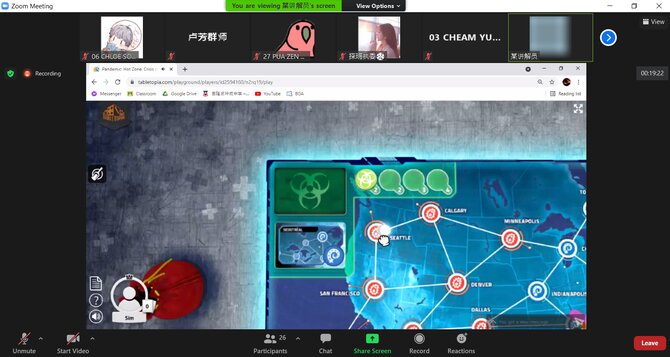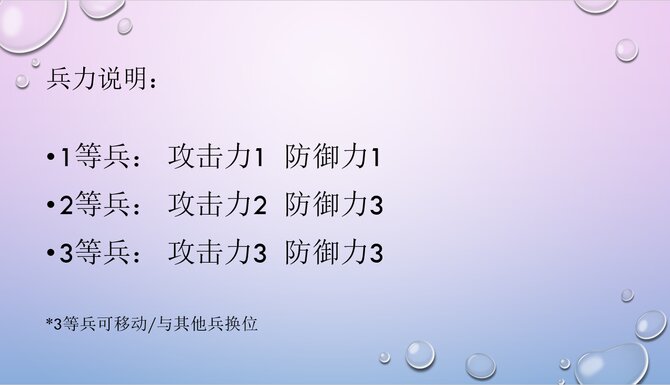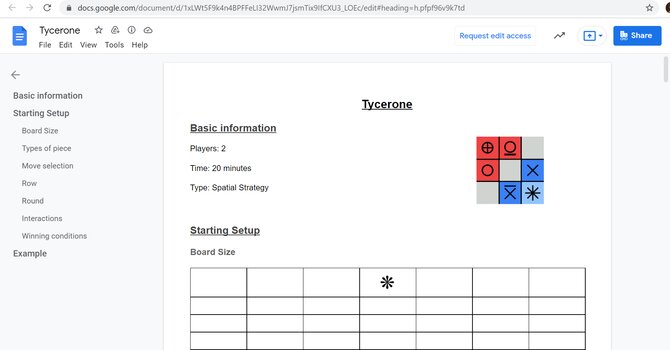Reported by:
Chloe Soh Ke Er Jr1Z(3)
On the 7th, 9th and 10th of June, Kuen Cheng Boardgame Society held three board game workshops. All students of Kuen Cheng High School were welcomed to join the workshop.
1st day: Pandemic (瘟疫危机)
First day of the 7th of June, they kicked off the workshop with an online board game called Pandemic. It is played on an online website called Tabletopia, which contains over 900 board games for people to play online.
The workshop started with the committee members explaining and demonstrating the steps to sign in to the website as well as the rules and regulations of the game. Participants were then divided into a few groups from 3 to 4 people in each group. Then, they were asked to join a room created by one of them and start playing the game. They are encouraged to share their screens so that the committee members in charge could supervise the whole game.
 The committee members demonstrating the actions of the game
The committee members demonstrating the actions of the game
The game is simulating a virus outbreak, which is what the whole world is facing now – the Covid-19 virus outbreak. It is a cooperative board game. The goal of the game is for the players, in their randomly selected roles, to work cooperatively to stop the spread of four diseases and cure them before a pandemic occurs. At the start of the game, Infection cards are randomly drawn to populate the board with infections, from 1 to 3 cubes for a number of cities. Players started at Atlanta, the home of the Centers for Disease Control, and are given a random role and a number of Player cards based on the number of players.
On each turn, a player can take up to 4 actions, consisting of any combination of the 8 possible actions which include curing. After taking their actions, the player draws two Player cards. If one player drawed an Epidemic card, the player moves the Infection rate marker one space, draws a card from the bottom of the Infection deck and places three cubes on that city, puts that card into the Infection discard pile and reshuffles the discard pile. After the two Player cards are drawn, a number of Infection cards are revealed, and one cube of the indicated color is placed on each city drawn. If a city already has three cubes and a new cube is to be added, an Outbreak occurs, and each interconnected city gains one cube of that color. This can create a chain reaction across many cities if they already have three disease cubes on them. After the infections are resolved, the next player has a turn.
The game is over if the players either win by discovering the cure for all four diseases, or lose by having 8 outbreaks, not having enough disease cubes of a color to place at any time, or not having enough Player cards when someone needs to draw.
The workshop was supposed to end at 3pm, but participants were allowed to stay in the Zoom meeting if they wanted to continue playing.
2nd day: Dixit (只言片语)
On 9th June, the second workshop, Dixit was held. As before, the committee members explained the rules of the game and separated participants into separate room, each room containing 3 to 8 participants.
Before each game, players will be given random cards. There will be a storyteller each round of the game which every player has a chance to be. At the start of each round, the storyteller must choose a card and describe it to the other players. Then, the other players will need to find the card in their deck that seems similar to the card the storyteller described. After every player chooses a card, every card chosen is shown on the screen, and players vote to guess which is the storyteller’s card.
If every player guessed the card right, every player except the storyteller gets 2 points, same goes if every player guessed the card wrong, but the player which they guessed wrongly has only 1 point. If some players guessed right but some guessed wrong, players who guessed right and the storyteller got 3 points, the player which they guessed wrong would only get 1 point. At last, the player who has the most points wins.
Besides having fun, this game helps to encourage empathy and imagination, perfect for those who may find these skills challenging. It is also perfect for team building.
3rd day: Tycerone
10th June is the last day of the workshop, which is special because they are introducing Tycerone, which is an original game by four members of the board game society: Fong Tzyy Yu, Ng Wei Enn, Chan Wen Xu and Hamza Ali.
One of the game’s founders, Ng Wei Enn explained the rules of Tycerine to the participants. Tycerine is the basic version of Tycerone because it is hard to play Tycerone without mastering Tycerine, as Tycerone’s rules are even more complicated than Tycerine, which makes it very challenging.
Tycerine is played with 2 players. The two parties will occupy the end of the rectangle in a special rectangle. Then the players will take turns out of pawns, and within the range of the nine squares, they can generate first-level pawns (Pawns) with a defensive power and attack power of 1. After accumulating enough first-level pawns and arranging them into a fixed formation, the middle first-level pawns can be upgraded to second-level pawns (defenders) with a defense and attack power of 2, or even third-level soldiers (Hoppers) with a defense and attack power of 3. When both players collide, the sum of the defensive power and the attack power of the two colliding chess pieces and the pieces around them (within 9 squares) is calculated, and the weaker one will get destroyed, including the pieces around it.
 The power of the three level pieces.
The power of the three level pieces.
After the explanation, Wei Enn also asked the participants to enter the website created by them and experience the gameplay of Tycerine firsthand, and even welcomed them to challenge him. After some time of playing, Wei Enn continued to explain the rules of Tycerone to the participants. In Tycerone, a new combat command is added such as March, which a soldier can be placed in front of the chess piece, fortify, which a pawn will be placed on the side or behind the chess piece, fusion, which a watcher or breaker will be combined, and the player can give instructions to the opponent and the opponent can choose whether to obey or not. Due to the time limit, there are many other rules that Wei Enn did not manage to explain, but he gave the participants a google doc link which is the handbook of Tycerone. Participants can read the rules and try to play it with a pen and a paper or a 7×9 table in Microsoft Excel.
 The English version handbook of Tycerone.
The English version handbook of Tycerone.
The three day workshops eventually ended successfully.
Many thanks to the Board Game Society for organizing this board game workshop during the holiday, allowing participants to get in touch with board games virtually. Students benefited from the workshops organised.


